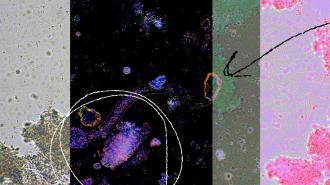Stanford University scientists have discovered what appears to be a brand-new class of virus-like organisms in the human gut microbiome. If confirmed, the next step will be figuring out whether the strange creatures are helpful or harmful to human health.
“It’s insane,” Mark Peifer, a cell and developmental biologist at the University of North Carolina at Chapel Hill, who wasn’t involved in the research, told Science. “The more we look, the more crazy things we see.”
The background: You have trillions of microbes living in your digestive tract, and usually, that’s a good thing — some of these tiny hitchhikers help you stay healthy by producing vitamins, aiding in food digestion, and keeping bad bacteria in check.
If the balance of those microbes, known collectively as your “gut microbiome,” is thrown off, though, it could make you sick — scientists have found correlations between an imbalanced microbiome and a higher risk of diabetes, cancer, mood disorders, and more.
“It’s really affecting a considerable amount of the sample.”
Joan Marquez-Molins
What’s new? The more we can learn about the gut microbiome, the better our ability to change it to improve our health. A Stanford-led team has just made a potentially major discovery, uncovering a brand new class of gut-dwelling organisms.
They call these creatures “obelisks,” and they found them inside bacteria taken from human guts and mouths. They appear to be fairly common, too, turning up in 7% of the gut bacteria samples and 50% of the oral bacteria samples the researchers analyzed.
“It’s not really something sporadic or isolated in the population — it’s really affecting a considerable amount of the sample,” Joan Marquez-Molins, a molecular biologist at the Swedish University of Agricultural Sciences, Uppsala, who was not involved in the work, told Nature.
The details: According to the researchers’ paper, which has been shared on the preprint server bioRXiv, obelisks are similar to “viroids.” These tiny loops of RNA can infect other organisms, like viruses can, but because they lack coding for proteins, they don’t have viruses’ characteristic protein shell.
Viroids were discovered in plants, but newer research suggested they might be able to infect bacteria and other organisms, too, so the Stanford team developed a tool that could search through databases of RNA sequences for ones likely to form loops, hoping to find more viroids.
“We are still exploring the frontiers of this viral universe.”
Simon Roux
This led to the discovery of nearly 30,000 sequences with too few bases to be RNA viruses. Like viroids, they lacked the coding to create a protein shell, but unlike viroids, the sequences included coding for other proteins. The team named them “obelisks.”
“I am really impressed by the approach,” Simon Roux, a computational biologist at the Department of Energy’s Joint Genome Institute, who wasn’t involved in the study, told Science. “The authors were really creative.”
Looking ahead: The research still needs to be confirmed through peer-review, but if the Stanford team has discovered something new and yet so common in the human gut, the next step will be figuring out what, if any, impact it has on human health.
“I think this [work] is one more clear indication that we are still exploring the frontiers of this viral universe,” said Roux.
We’d love to hear from you! If you have a comment about this article or if you have a tip for a future Freethink story, please email us at tips@freethink.com.
